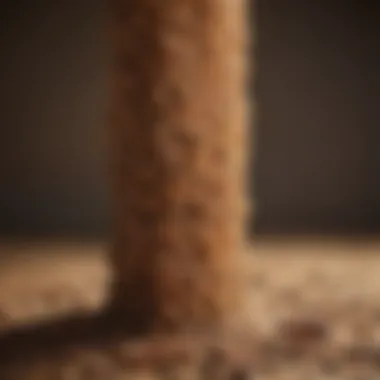Understanding Exterra Termite Bait Stations: A Comprehensive Guide


Intro
Termite infestations pose a serious concern for homeowners. The damage they cause can be extensive, impacting the structural integrity of homes and properties. Exterra termite bait stations serve as a strategic method to prevent and control these pests. Understanding them not only requires knowledge of their operation but also awareness of the termites that threaten homes and the broader implications for the environment.
Identification of Common Pests
Description of Common Pests
When it comes to termites, the most common species include the Eastern Subterranean Termite, Formosan Termite, and Drywood Termite. Eastern Subterranean Termites are known for their destructive habits and are commonly found in the eastern United States. They thrive in soil and require moisture to survive. Formosan Termites are more aggressive, nesting in large colonies and causing rapid damage. Drywood Termites, on the other hand, live within the wood they consume and are typically found in warmer climates.
Signs of Infestation
Identifying a termite infestation early can save homeowners from severe damage. Common signs include:
- Mud Tubes: These tubes are constructed from soil and saliva, allowing termites to travel between their nest and food source.
- Damaged Wood: If wood sounds hollow when tapped or has visible channels, it is likely infested.
- Excrement: Termite droppings resemble sawdust or small pellets and can often be found near infested areas.
Prevention Techniques
Home Maintenance Tips
Regular maintenance is crucial in preventing termite infestations. Homeowners should:
- Keep wood piles away from the foundation
- Seal any cracks or openings in the foundation
- Ensure that gutters and downspouts are directing water away from the home
Environmental Modifications
Modifying the environment around the home can deter termites. Some effective strategies include:
- Maintaining a dry landscape, avoiding excessive moisture in soil
- Using resistant materials when building or renovating, such as steel or concrete
- Creating a barrier with chemical treatments as a proactive measure
Eco-Friendly Pest Control Options
Natural Pesticides
Natural pesticides offer an alternative to traditional chemicals. Some of the most effective natural methods include:
- Boric Acid: Used as a bait, it can disrupt the digestive system of termites.
- Nematodes: These microscopic worms can enter termite bodies and kill them without harming other organisms.
Organic Pest Control Techniques
Considering organic options for pest control can contribute to a healthier environment. These techniques not only target termites but also cover a broader pest management approach. Examples include:
- Maintaining healthy soil and plants around the property to discourage infestations.
- Using diatomaceous earth to create a barrier against pests.
It is essential to integrate pest management practices that respect the environment while effectively controlling termite populations.
Intro to Exterra Termite Bait Stations
Termite infestations pose a significant threat to homes and buildings. Exterra termite bait stations offer a proactive solution for homeowners to combat this issue effectively. Understanding these systems is crucial for maintaining the integrity of one’s property. This article delves into Exterra bait stations, focusing on their benefits, how they operate, and their place within modern pest management strategies.
What Are Exterra Termite Bait Stations?
Exterra termite bait stations are specialized devices designed to attract and eliminate termites. They are installed around a property’s perimeter and contain a bait that appeals to foraging termites. Once termites consume the bait, it disrupts their life cycle, leading to population decrease and elimination over time. This method minimizes chemical exposure to the surrounding environment while targeting the termites directly.


The stations are made of durable materials and are designed to work effectively across various climates. Regular monitoring allows homeowners to keep track of any termite activity and assess the need for additional interventions. Unlike traditional chemical treatments, Exterra systems focus on long-term prevention rather than immediate eradication.
Historical Development of Termite Bait Technologies
Termite control has evolved significantly over the years. Early methods relied heavily on direct applications of chemicals to structures. However, this approach often led to environmental concerns and resistance among termite populations.
The introduction of bait technology marked a turning point. In the late 20th century, researchers began developing bait systems that appealed to termite behavior. This shift highlighted the understanding of social insects and their foraging patterns. Companies like Exterra pioneered this technology, offering systems that integrated seamlessly into the environment.
As science advanced, the efficacy of bait systems improved, resulting in more reliable and environmentally friendly pest management solutions. Today, Exterra bait stations represent a culmination of years of research and practical application, providing an effective alternative to traditional methods.
Operational Mechanism of Exterra Bait Stations
The operational mechanism of Exterra termite bait stations plays a crucial role in their function as a pest control solution. Understanding how these systems work can help homeowners recognize their value. Exterra bait stations utilize a systematic approach to control termite populations effectively. This section delves into the intricacies of the baiting process, the types of insecticides employed, and how these bait stations manipulate termite behavior.
How the Baiting Process Works
The baiting process begins with the installation of Exterra bait stations around a property. These stations contain a cellulose-based bait material that attracts termites. Once termites locate the bait, they consume it and transport it back to their colony. This activity is essential as it enables the active components in the bait to spread throughout the colony.
When termites ingest the bait, the active ingredient starts disrupting their natural growth processes. It's designed to target specific biological functions that lead to colony decline over time. The effectiveness of this process hinges on patience as it may require weeks or months to observe a significant reduction in termite activity. Homeowners must remain vigilant about monitoring the stations regularly for signs of termite activity.
Types of Insecticides Used
Exterra primarily employs insect growth regulators (IGRs) as the active ingredients in their bait systems. A notable compound used is hexaflumuron. This IGR disrupts the termites' molting process, ultimately leading to their death. The advantage of using an IGR is its targeted action against the termites while minimizing harm to other beneficial insects in the ecosystem.
Another product commonly utilized is tafenozide, which acts as a growth regulator as well. This mode of action ensures that termites can no longer grow and reproduce effectively. Homeowners appreciate this because it presents a lesser risk of chemical exposure compared to traditional liquid treatments, while maintaining potency against termite infestations.
Role of Bait Stations in Termite Behavior Manipulation
Bait stations do more than just eliminate termites; they act as a strategic tool for manipulating termite behavior. By strategically placing bait stations in locations where termites are likely to travel, homeowners can encourage termites to feed on the bait. This method maximizes exposure to the active ingredients, promoting an efficient decline of the colony.
Furthermore, these stations exploit the social behavior of termites. Termites share food with one another, allowing the bait to distribute rapidly throughout the colony. The designing of the bait stations ensures they remain attractive and accessible, thereby enhancing the chances of termites interacting with them.
Effective use of Exterra bait stations hinges on understanding termite behaviors and exploiting them through precise application.
Effectiveness of Exterra Termite Bait Stations
The effectiveness of Exterra termite bait stations is crucial for homeowners seeking reliable pest control solutions. Understanding how these bait stations work, their advantages over traditional treatments, and their long-term efficacy is essential to making informed decisions about termite management. Exterra offers a unique approach that prioritizes targeted action against termites, reducing overall pesticide usage, which is vital for health and environmental considerations.
Comparative Analysis with Traditional Treatments
When assessing Exterra bait stations against traditional termite treatments, such as liquid barrier treatments or fumigation, several factors should be considered. Traditional methods often utilize broad-spectrum chemicals that act quickly but can pose health risks to residents and pets. In contrast, Exterra focuses on attracting termites to bait stations where specialized insecticides can be administered effectively.
- Targeted Approach: Unlike broad-spectrum treatments, Exterra systems are designed for termite targeting. This specificity reduces collateral damage to beneficial insects.
- Lower Chemical Load: The baiting system requires fewer chemicals in the environment compared to traditional methods, which often necessitate application over large areas.
A meta-analysis of pest management practices indicates that targeted approaches are not just effective but are also increasingly preferred among environmentally conscious homeowners.
"Exterra bait stations provide a proactive method that eliminates termites while safeguarding human health and local ecosystems."
Efficacy Over Time
The efficacy of Exterra bait stations is linked directly to their design and operational principles. Initial installation may take time to show significant results, largely due to the need for termites to discover and consume the bait. However, studies reveal that once established, these systems can be both effective and efficient in long-term pest control.
- Feeding Cycle Considerations: Termites have specific feeding cycles, which means they may not immediately interact with bait stations after installation. Monitoring is key to evaluating efficacy.
- Long-Term Effects: Research demonstrates that, when properly maintained, Exterra bait stations maintain their effectiveness over extended periods. This longevity can mean fewer interventions and reduced costs in ongoing termite management.


Success Stories and Case Studies
Several case studies illustrate the success of Exterra bait stations in various residential settings. One notable instance involved a suburban homeowner dealing with recurrent termite issues. After switching to Exterra bait stations, the homeowner experienced a marked decrease in termite activity within six months. Continuing observation indicated sustained success well beyond the initial installation phase.
- Community Reports: Numerous homeowners shared positive experiences through community forums on platforms like Reddit, indicating satisfaction with the results of Exterra systems.
- Professional Endorsements: Pest control professionals often recommend Exterra systems based on successful outcomes in their operations, emphasizing the reduced need for re-treatment in homes using these systems.
The evidence accumulates, showcasing Exterra bait stations as a formidable option for termite management, offering effective solutions tailored for conscientious property owners.
Advantages of Using Exterra Termite Bait Stations
Exterra termite bait stations offer several advantages for homeowners facing the threat of termite infestations. The unique design and operational principles of these systems provide effective, targeted solutions. Understanding these benefits is crucial for anyone considering different approaches to pest management.
Targeted Approach to Termite Control
One of the primary benefits of Exterra termite bait stations is their targeted approach to termite control. Unlike traditional methods that often involve widespread chemical application, these bait stations focus on attracting termites directly. This means that only the pests are impacted, thus minimizing disruption to non-target organisms in the ecosystem.
The bait stations use wood or other cellulose materials that serve as attractive food sources for termites. Once termites find the bait, they consume it and carry it back to their colony. Effectively, this induces a domino effect as other colony members, exposed to the toxic bait, also feed on it. It leads to a more efficient elimination of the colony. Each bait station is strategically located around a property, often tailored to specific needs based on previous termite activity.
Reduced Chemical Exposure for Homeowners
Second, these bait stations contribute to a reduced chemical exposure for homeowners. They limit the amount of pesticide directly applied to the property. This can be particularly appealing for family-oriented or environmentally-conscious homeowners who prioritize safety.
By utilizing a baiting system, there is no need for entire property treatments that can linger in the soil or structure. Instead, the chemicals are contained within the bait, significantly lowering the potential health risks associated with chemical exposure. This is especially vital for homes with children or pets, where maintaining a safe living environment is of utmost importance.
Minimizing Environmental Impact
Lastly, using Exterra termite bait stations helps minimize environmental impact. Traditional termite control methods often involve rampant chemical usage which can affect soil health and non-target wildlife. In contrast, Exterra's approach focuses primarily on the target species while reducing the ecological footprint.
The systemic nature of the bait’s active ingredients leads to localized treatment. This means fewer chemicals are needed, and there is less risk of runoff affecting local water systems or harming beneficial insects. Homeowners can feel compelled that they are making a responsible choice that not only protects their property but also contributes to broader environmental health.
Thorough understanding of these advantages can guide property owners in making informed decisions about their pest control strategies.
Challenges and Limitations of Exterra Bait Stations
The use of Exterra termite bait stations presents various challenges and limitations that homeowners should consider. It is essential to understand these factors to set realistic expectations regarding termite control. While effective, termite bait systems are not a one-size-fits-all solution. Issues such as delayed efficacy, the life cycle of termites, and cost considerations can influence their effectiveness. Finding a balance between these challenges and the benefits offered can help homeowners make informed decisions about pest management.
Potential Delays in Efficacy
One significant challenge associated with Exterra termite bait stations is the potential delay in their efficacy. Unlike traditional liquid treatments that provide immediate results, bait stations rely on a different mechanism. The bait must be consumed by the termites and shared among the colony. This process can take time. It is not uncommon for homeowners to notice termite activity well after bait installation. Delays can also occur due to environmental factors, such as the colony's foraging habits or food sources being nearby. Therefore, homeowners must be patient and allow time for the bait system to demonstrate its effectiveness.
Life Cycle Considerations of Termites
Another aspect to consider are the life cycles of termites. Termite colonies undergo complex stages from egg to adult, and each stage has different behaviors. In some cases, newly formed colonies may not readily feed on the bait. They could prioritize other food sources or resist the bait due to varied preferences. The timing of the installation relative to the colony's growth can significantly affect treatment outcomes. Homeowners should factor in these cycles when planning and implementing Exterra bait stations to ensure maximum effectiveness against these pests.
Cost Considerations in Implementation
Lastly, the cost of implementing Exterra systems cannot be overlooked. While bait stations can provide considerable benefits, the initial investment can be higher compared to traditional treatments. Homeowners might need to budget for the set-up and ongoing maintenance. Regular monitoring is crucial to ensure that the stations remain effective. Although the long-term benefits can outweigh the initial costs, it is vital to assess one's budget and the potential for pest activity before moving forward with Exterra systems. Understanding both the financial implications and the potential savings over time can guide homeowners in making sound decisions for termite control.
Installation and Maintenance of Exterra Termite Bait Stations
The installation and maintenance of Exterra termite bait stations is critical for their overall effectiveness in protecting homes from termite infestations. Properly setting up the stations ensures they function as intended, attracting and eliminating termites before they can cause significant damage. On the other hand, regular maintenance is necessary to monitor the system's performance and address any potential issues before they escalate. This section discusses the essential guidelines for initial setup, the importance of consistent monitoring, and how to handle common maintenance concerns.
Initial Setup Guidelines


Setting up Exterra termite bait stations involves careful planning and execution. Begin by selecting appropriate locations around the perimeter of the property where signs of termite activity have been observed or where conditions are conducive to termites.
- Placement: Install stations in areas with soft, moist soil, as this attracts termites. Areas near suspect wooden structures or landscaping features that touch the ground are ideal.
- Spacing: Position the stations approximately 10 to 20 feet apart. The closer the stations are to each other, the better the chances of detecting termite activity early.
- Installation Depth: Typically, the bait station should be placed several inches below ground level, allowing termites direct access while hiding the stations from view.
After installation, ensure each station is securely closed and well-marked to facilitate easy identification during monitoring sessions.
Regular Monitoring Practices
Regular monitoring is paramount in the ongoing effectiveness of Exterra bait stations. Homeowners should check these stations at a minimum of every 60 days during the active season to assess for termite activity. Key practices include:
- Visual Inspections: Look for signs of termite activity, such as mazes of mud in the stations or the presence of termite bodies in the bait. This helps in determining if the baiting process is effective.
- Bait Replacement: If the bait is being consumed, it suggests termites are active. Replace the bait as needed, following the manufacturer's instructions to ensure optimal efficacy.
- Documentation: Keeping a log of inspection dates and findings is vital. This will help track patterns over time, highlighting any changes in termite behavior or activity levels.
Regular monitoring is an essential part of caretaking for an Exterra system. Through consistent checks, homeowners can proactively address any signs of infestation.
Dealing with Maintenance Issues
Despite the best initial setup and monitoring, maintenance concerns can arise. Here are some common issues along with their solutions:
- Station Malfunction: If a station appears to be damaged or not functioning, inspect it thoroughly. Repair or replace any broken components immediately to maintain the system's integrity.
- Weather Impacts: Heavy rain or flooding can cause stations to be washed out. Be prepared to relocate stations or reinforce them as needed to prevent such occurrences.
- Pest Interference: Sometimes, non-target pests may interfere with the bait systems. If this happens, consider adjusting the bait to a less accessible location.
Homeowners should remember that the goal of these bait stations is proactive control. Addressing issues promptly will ensure that they continue to protect the premise from termites effectively.
Integration of Exterra Systems into Broader Pest Management Strategies
Integrating Exterra termite bait stations into a wider pest management strategy is essential for effective and sustainable pest control. This integration helps in aligning various methods to create a comprehensive defense against termite infestations, ensuring that homeowners can protect their properties efficiently. When considering the multifaceted aspects of pest control, recognizing how Exterra systems fit into the larger picture is crucial.
Complementing Other Pest Control Measures
Exterra bait stations do not operate in isolation. They are most effective when combined with other pest control strategies. Utilizing these stations alongside traditional methods, such as chemical treatments or physical barriers, can enhance overall effectiveness. For example, while bait stations attract and eliminate termites from within, treating the perimeter of a home with liquid insecticides can provide an additional layer of protection.
- Physical Barriers: Installing physical barriers can prevent termites from entering a property while bait stations address existing infestations.
- Regular Inspections: Scheduling regular inspections complements the use of bait stations. Trained professionals can monitor the situation, ensuring that if activity is detected, it can be swiftly addressed.
This layered approach not only improves results but also offers homeowners peace of mind, knowing that they are utilizing multiple protective methods.
Creating Comprehensive Pest Management Plans
A comprehensive pest management plan should incorporate Exterra systems as one of its core components. Developing such a plan involves careful planning and consideration of several factors.
- Assessment of Property: Every pest control plan should start with an assessment of the property. This assessment helps determine the extent of potential termite damage and the best locations for bait station installation.
- Custom Solutions: Homeowners must design their pest management plan to fit their specific needs. This might include combinations of baiting systems, chemical treatments, and natural deterrents.
- Education and Awareness: Education plays an important role in any pest management plan. Homeowners should be informed about the biology of termites and the operation of Exterra systems. This knowledge empowers them to take proactive measures against infestations.
A well-rounded approach that combines these elements will enhance the effectiveness of Exterra systems, ultimately contributing to better management of pests.
In summary, integrating Exterra systems into broader pest management strategies increases efficacy, mitigates risks, and provides a stronger defense against termite infestations while promoting environmentally responsible practices.
By understanding these management strategies, homeowners can adopt a proactive stance towards keeping their properties safe from termites.
End
The conclusion serves as a critical reflection on the roles and implications of Exterra termite bait stations within the broader context of pest management strategies. Understanding the effectiveness and deployment of these systems is vital for homeowners who seek reliable and sustainable solutions to combat termite infestations.
Firstly, it is important to acknowledge that Exterra termite bait stations offer a targeted approach to termite control. This specificity is beneficial as it minimizes the impact on non-target species, making it an environmentally considerate option. Proper understanding of their operational mechanisms reassures homeowners about their effectiveness in safeguarding their properties. The integration of these systems into comprehensive pest management plans enhances overall defense against not only termites but also other household pests.
Furthermore, this article highlighted the significance of regular monitoring and maintenance practices. These practices ensure the longevity of the bait systems and their continued effectiveness. Homeowners are encouraged to actively engage with these systems, promoting a proactive stance against potential infestations.
"Knowledge is power, especially when it comes to protecting your home from invasive species like termites."
Final Thoughts on Using Exterra Termite Bait Stations
Using Exterra termite bait stations is not just about treatment; it's about an informed strategy against one of the most destructive pests. Homeowners should consider the system's advantages, such as reduced chemical exposure and tailored pest management approaches. Similarly, grasping the challenges involved, from potential delays in seeing results to financial commitments in setup, is essential. While these bait stations do require ongoing engagement and awareness, their role in effective termite control is clear. By integrating this solution into everyday property maintenance, homeowners create a resilient defense against termite threats.







